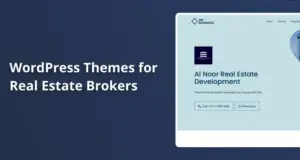Ah, the excitement of a high-traffic event! It’s like hosting an open house for your most expensive real estate listings—you want everything to shine and run smoothly. As someone who’s worked with real estate websites, I know how important it is to make a great first impression.
Nothing turns potential buyers or clients away faster than a sluggish site. So, how do you ensure your real estate WordPress site stays fast, responsive, and ready to handle the surge? Let’s dive into the strategies to prepare your site for a high-traffic event and keep your digital doors open for business.
Choose a Reliable Hosting Provider
First things first, you need a solid foundation. Think of your hosting provider as the venue for your party. You wouldn’t throw a concert in a shoebox, right? So, opt for a hosting provider that can handle the crowd. Managed WordPress hosting plans often include features like automatic scaling and caching, which are vital during traffic spikes. I’ve had great experiences with WP Engine and SiteGround. They’re like the bouncers you never knew you needed.
Implement Caching Mechanisms
Caching is like having a pre-made drink ready for every guest. It reduces server load by storing static versions of your pages. Use caching plugins such as W3 Total Cache or WP Super Cache to enable browser and page caching. Trust me, your server will thank you, and your visitors will love the faster load times.
Optimize Images and Media
We all love pretty things, but high-resolution images can slow down your site. Compress images using tools like TinyPNG or plugins like Smush to reduce file size without losing quality. Enable lazy loading so images load only when they’re visible on the screen. It’s like serving appetizers one by one, not all at once. Your server won’t get overwhelmed, and your guests won’t feel stuffed before the main course.
Minimize HTTP Requests
Every little detail counts when you’re hosting an event. Combine CSS and JavaScript files to reduce the number of requests. Remove unnecessary plugins and scripts. Limit the use of external resources like third-party fonts and ads. Use tools like Pingdom to identify and reduce HTTP requests. It’s like asking your DJ to play fewer songs but make each one count.
Use a Content Delivery Network (CDN)
A CDN is like having multiple entrances to your venue. It distributes your site’s assets across multiple servers worldwide, ensuring faster delivery to visitors by serving content from the server closest to their location. Recommended CDNs include Cloudflare or BunnyCDN. It’s like having satellite bars so no one has to wait in line for a drink.
Optimize Your Database
After every event, there’s some cleanup to do. Regularly clean your WordPress database to remove unnecessary data like post revisions, spam comments, and expired transients. Use plugins like WP-Optimize or Advanced Database Cleaner to automate this process. A streamlined database improves query performance and reduces load times. It’s like clearing the dance floor for the next big hit.
Monitor Site Performance
Imagine driving a car without a speedometer. You wouldn’t know if you’re going too fast or too slow until it’s too late. The same goes for your website. Tools like Google Analytics, Jetpack, or Pingdom are your dashboard, showing real-time performance data. Set up alerts for downtime or slow response times to act quickly. Keeping an eye on your site’s performance helps you resolve issues before they affect your visitors, ensuring a smooth ride for everyone.
Prepare a Backup Plan
Before you start making changes to handle more traffic, create a complete backup of your site. Think of it like wearing a life jacket before going canoeing. Plugins like UpdraftPlus or VaultPress automate this process, keeping your data safe and sound. Store these backups in a remote location like cloud storage. This way, if something goes wrong, you can quickly restore your site and keep your audience happy.
Test Your Site’s Load Capacity
Ever wondered how many people your site can handle at once? Load testing is like inviting friends over to see how many can fit in your living room before it gets uncomfortable. Tools like LoadImpact or BlazeMeter simulate high-traffic scenarios, helping you find potential bottlenecks. By making adjustments based on test results, you’ll ensure your site stays up and running, no matter how popular it gets.
Clean Up Your Site
A cluttered website is like a messy room—it’s hard to find what you need, and it just doesn’t feel right. Remove outdated pages, images, and videos that no longer serve a purpose. Compress any remaining media files to reduce server load. Your visitors will thank you with longer stays and more engagement.
Adopt a Minimal Design
When it comes to web design, less is often more. Simplify your layout by reducing the number of elements on each page. Limit heavy graphics, animations, and scripts that can slow down your site. A clean design not only speeds up your site but also makes navigation more intuitive, keeping visitors engaged longer.
Remove Unnecessary Plugins and Themes
Your WordPress site might be loaded with plugins you don’t even use. It’s like carrying around extra baggage—why? Deactivate and remove any plugins that are not in use. Opt for lightweight themes that are optimized for performance. Your site will load faster, and your visitors will appreciate the speed boost.
Optimize JavaScript and CSS
Minification may sound technical, but it’s simply removing unnecessary characters from your code. Tools like Autoptimize and WP Super Minify can do this for you, reducing file sizes and speeding up your site. It’s like cleaning out your garage and finding more space than you thought you had!
Reduce Time to First Byte (TTFB)
This is all about optimizing server response times. Use performance testing tools like Pingdom and GTMetrix to measure and improve TTFB. These platforms provide actionable insights that help you configure your hosting environment for optimal performance.
Address Hardware Limitations
Imagine trying to run a marathon in flip-flops. Yeah, that’s your server without the right hardware. Ensure your server has adequate CPU power and memory. It’s like giving your site a pair of top-notch running shoes. When it comes to MySQL/MariaDB optimization, adjust settings, enable query caching, and index wisely. Think of your database as a well-organized library—you’ll find your books (or data) a lot faster.
For your web service configuration, always run the latest stable versions and pick efficient PHP handlers( It’s like upgrading your kitchen to handle more guests at once.)
Don’t forget about network limitations; ensure your server’s network adapter supports high transfer speeds to prevent bottlenecks. And be aware of transfer overages—no one likes surprise charges, especially when you’re celebrating a traffic milestone!
Implement Service-Oriented Architecture
If your website were a restaurant, this is where you’d hire more staff. Use separate servers for web hosting, databases, caching, and media to distribute the load effectively. Load balancing is your maître d’, ensuring no single server gets overwhelmed.
Utilize Advanced Caching Solutions
Varnish Cache is like having a personal assistant who answers your guests’ questions before they even reach your door. Deploy Varnish in front of your web server to serve cached pages directly from memory, reducing server load. Just ensure it’s configured properly to handle WordPress cookies; you don’t want your guests munching on stale ones!
Optimize Image Delivery
Sirv is the friend who brings a platter of beautifully arranged, bite-sized snacks to your party. Use services like Sirv to optimize images dynamically, delivering them in optimal formats and sizes. This reduces server load and bandwidth usage, making your site feel light on its feet.
Evaluate Hosting Needs
If your current hosting plan feels like a studio apartment when you need a penthouse, it’s time to upgrade. Consider virtual dedicated hosting, dedicated servers, or load-balanced multiple server setups to accommodate increased demand.
Optimize Site Speed
Loading speed is veryimportant for user experience and server efficiency. Conduct speed tests using tools like Google PageSpeed Insights to assess performance. Based on test results, implement recommended optimizations such as image compression, browser caching, and minimizing CSS and JavaScript files.
Understand Traffic Patterns and Capacity
Analyze current traffic patterns using tools like Google Analytics to monitor visitor behavior, peak times, and traffic sources. Conduct load testing with tools such as LoadImpact or BlazeMeter to simulate high-traffic scenarios and identify potential bottlenecks.
Security, Updates, and Maintenance
Keep your WordPress core, themes, and plugins updated to patch vulnerabilities. Implement security measures, such as using security plugins and enforcing strong passwords. Regular backups are essential for quick recovery in case of data loss.
By integrating these strategies, you can significantly enhance your WordPress site’s ability to handle high-traffic scenarios, ensuring optimal performance, reliability, and security. Employing robust caching mechanisms, optimizing your database, implementing a content delivery network (CDN), and leveraging scalable hosting solutions are critical steps.
Additionally, regularly updating your themes, plugins, and core files, as well as monitoring your site’s performance, can prevent potential bottlenecks. By taking these measures, you ensure your visitors experience a seamless, fast-loading, and error-free website, even during traffic spikes or heavy usage periods.
Our real estate WordPress theme works easily with important tools and services to improve your site’s speed, security, and performance. It’s designed to work smoothly with CDNs, caching plugins, monitoring tools, and backup systems, making sure your site is always fast and reliable. We regularly use and test services like Cloudflare, WP Super Cache, GTMetrix, and Varnish Cache to keep your website running well, even during busy times
Here is the list of all the services / tools mentioned in this article – Of course this is just get an ideea about what you need to use- I’m sure there also other alternatives.









